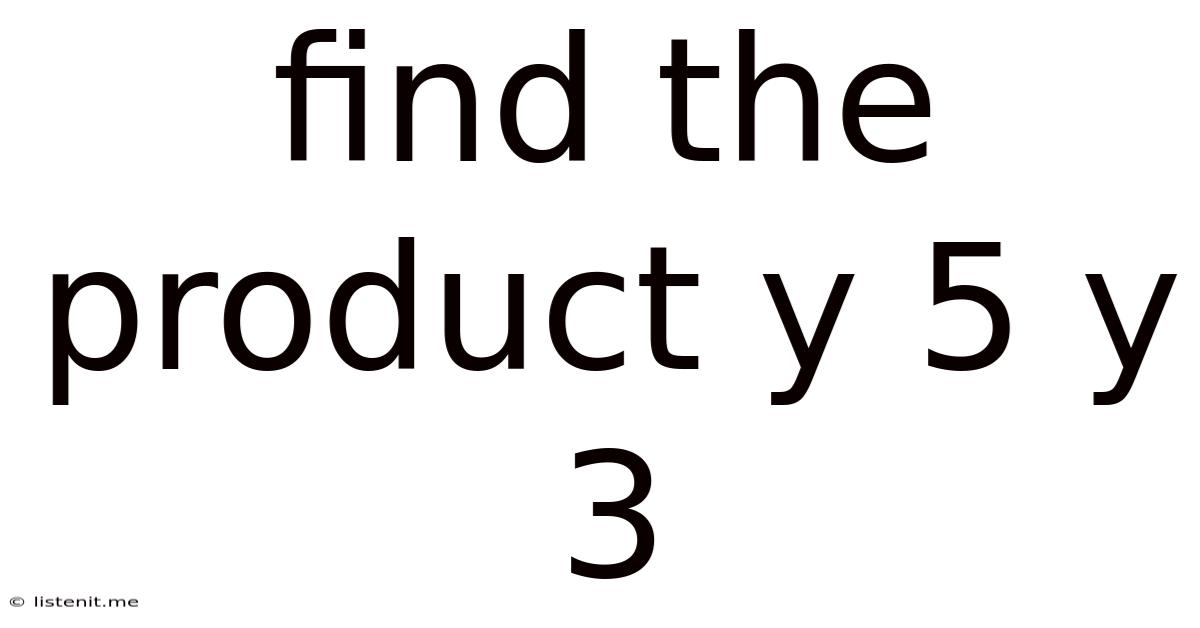Find The Product Y 5 Y 3
listenit
May 12, 2025 · 4 min read

Table of Contents
Finding the Product y⁵y³: A Deep Dive into Algebraic Simplification
Finding the product of y⁵ and y³ might seem like a simple algebraic task, but it opens the door to understanding fundamental concepts crucial for more complex mathematical operations. This article will thoroughly explore this seemingly simple problem, delving into the underlying principles of exponents, providing practical examples, and extending the concept to more advanced scenarios. We'll also touch upon the broader applications of these principles in various fields.
Understanding Exponents
Before tackling the multiplication of y⁵ and y³, let's solidify our understanding of exponents. An exponent (or power) indicates how many times a base number is multiplied by itself. For example:
- y² means y * y (y multiplied by itself twice)
- y³ means y * y * y (y multiplied by itself three times)
- y⁵ means y * y * y * y * y (y multiplied by itself five times)
The key here is to grasp that the exponent represents the number of times the base is used as a factor in the multiplication.
The Product Rule of Exponents
The multiplication of y⁵ and y³ is governed by the product rule of exponents. This rule states that when multiplying two exponential expressions with the same base, you simply add their exponents. Mathematically, this is represented as:
xᵃ * xᵇ = x⁽ᵃ⁺ᵇ⁾
Where:
- 'x' represents the base (in our case, 'y')
- 'a' and 'b' represent the exponents (in our case, 5 and 3)
Solving y⁵y³
Applying the product rule of exponents to our problem, y⁵y³, we get:
y⁵ * y³ = y⁽⁵⁺³⁾ = y⁸
Therefore, the product of y⁵ and y³ is y⁸. This means y multiplied by itself eight times.
Expanding the Concept: More Complex Examples
Let's extend our understanding with more complex examples:
Example 1: (2x²) * (3x⁴)
Here, we multiply the coefficients (2 and 3) separately and then apply the product rule to the variables:
(2 * 3) * (x² * x⁴) = 6x⁽²⁺⁴⁾ = 6x⁶
Example 2: (5a³b²) * (2a²b⁵)
In this case, we apply the product rule to each variable separately:
(5 * 2) * (a³ * a²) * (b² * b⁵) = 10a⁽³⁺²⁾b⁽²⁺⁵⁾ = 10a⁵b⁷
Example 3: (-4xy³) * (2x²y) * (-3x³y⁴)
Here we combine the coefficients and use the product rule for x and y separately:
(-4 * 2 * -3) * (x¹ * x² * x³) * (y³ * y¹ * y⁴) = 24x⁽¹⁺²⁺³⁾y⁽³⁺¹⁺⁴⁾ = 24x⁶y⁸
These examples demonstrate that the product rule applies regardless of the complexity of the expression, as long as the bases are the same.
Beyond Simple Variables: Incorporating Numbers
The product rule seamlessly integrates with numerical coefficients. The coefficients are multiplied independently, while the exponential terms follow the product rule.
Example 4: 3x² * 5x⁴ = (3*5)x⁽²⁺⁴⁾ = 15x⁶
Example 5: -2y⁵ * 4y² = (-2*4)y⁽⁵⁺²⁾ = -8y⁷
Negative and Fractional Exponents
The product rule extends even to negative and fractional exponents:
Example 6: x⁻² * x³ = x⁽⁻²⁺³⁾ = x¹ = x
Example 7: y¹/² * y³/² = y⁽¹/²⁺³/²⁾ = y²/² = y¹ = y
Example 8: 2a⁻³ * 3a⁵ = (2*3)a⁽⁻³⁺⁵⁾ = 6a²
Remember that x⁻ⁿ = 1/xⁿ and understanding fractional exponents as roots are crucial for working with these types of problems.
Applications in Various Fields
The seemingly simple product rule of exponents has far-reaching applications in numerous fields:
- Physics: Calculating quantities involving exponential growth or decay, such as radioactive decay or compound interest.
- Engineering: Analyzing circuits and signals, where exponential functions often describe the behavior of components.
- Computer Science: Analyzing algorithm efficiency and data structures, where exponential complexities are common.
- Finance: Modeling compound interest and financial growth, where exponential functions describe the accumulation of wealth over time.
- Biology: Modeling population growth, where exponential functions describe the increase or decrease of population sizes.
Troubleshooting Common Mistakes
A common mistake is forgetting to add exponents when multiplying terms with the same base. Another mistake is incorrectly handling the coefficients or signs when dealing with multiple terms. Always pay close attention to the signs of the coefficients and ensure that you are accurately applying the product rule for each variable in the expression.
Advanced Applications and Further Exploration
This simple concept of multiplying terms with the same base lays the foundation for significantly more complex algebraic manipulations. Understanding this will help you navigate concepts such as:
- Polynomial Multiplication: Multiplying expressions with multiple terms involving exponents.
- Binomial Theorem: Expanding expressions of the form (a + b)ⁿ.
- Calculus: Derivatives and integrals of exponential functions.
Conclusion
Finding the product of y⁵y³—resulting in y⁸—is more than just a simple calculation. It highlights the fundamental principle of the product rule of exponents, a cornerstone of algebra with significant practical implications across various disciplines. Mastering this concept is crucial for building a solid foundation in mathematics and preparing for more advanced mathematical explorations. By thoroughly understanding the principles outlined in this article, you will gain a strong grasp of algebraic manipulation and its applications in numerous fields. Remember to practice regularly with various examples to build fluency and confidence in applying this fundamental mathematical rule.
Latest Posts
Latest Posts
-
Is Bromine A Gas At Room Temperature
May 12, 2025
-
5 1 4 2 3 4
May 12, 2025
-
Which Color Of Light Has The Highest Frequency
May 12, 2025
-
Law Of Definite Proportions Law Of Multiple Proportions
May 12, 2025
-
What Macromolecule Makes Up The Majority Of The Cell Membrane
May 12, 2025
Related Post
Thank you for visiting our website which covers about Find The Product Y 5 Y 3 . We hope the information provided has been useful to you. Feel free to contact us if you have any questions or need further assistance. See you next time and don't miss to bookmark.